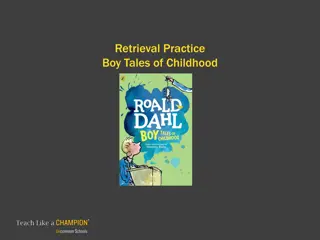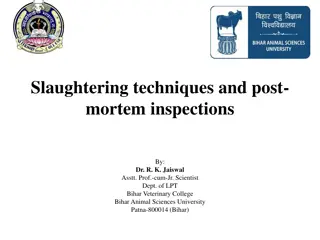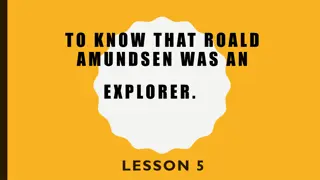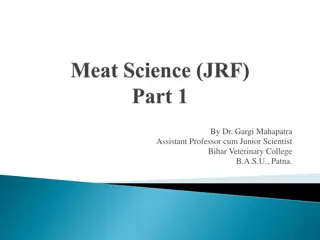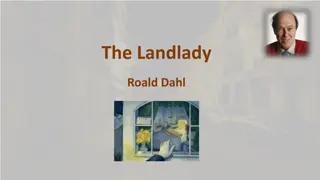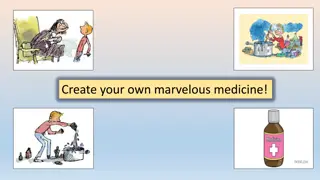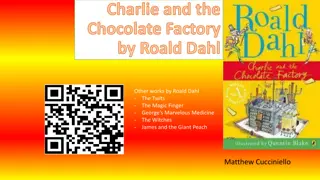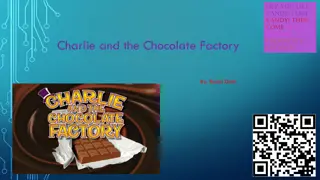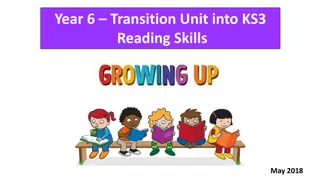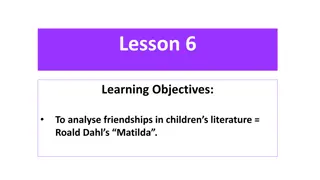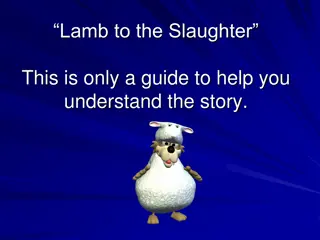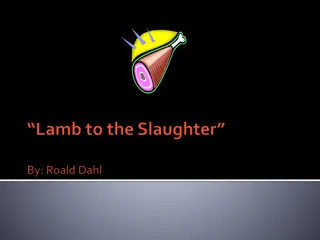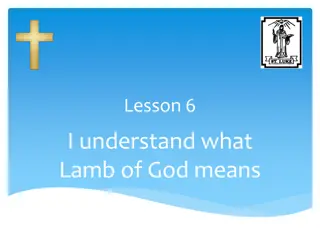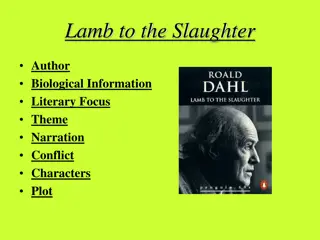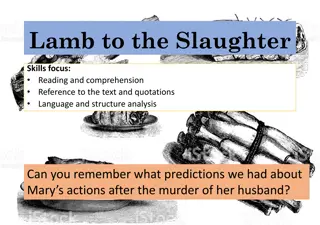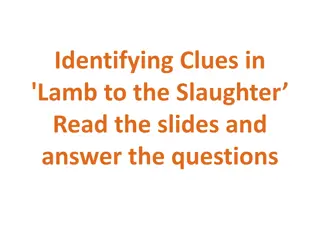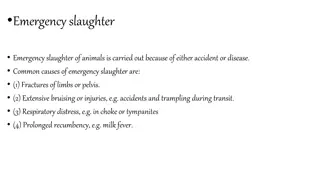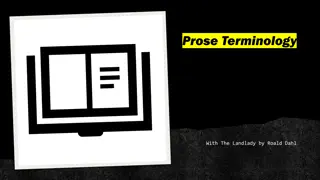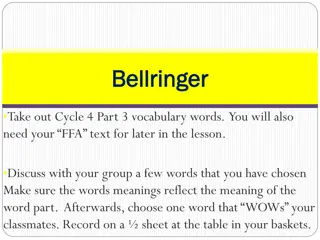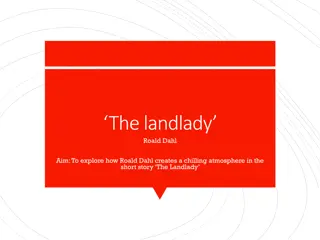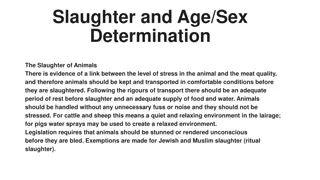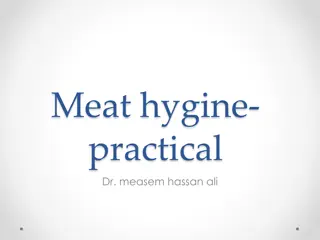Analyzing Suspense Techniques in Roald Dahl's "Lamb to the Slaughter
Analyze how Roald Dahl effectively creates suspense in "Lamb to the Slaughter." Explore elements such as suspense, irony, and verbal irony that contribute to the intense feeling experienced by the audience while waiting for the outcome of events within the story.
Download Presentation

Please find below an Image/Link to download the presentation.
The content on the website is provided AS IS for your information and personal use only. It may not be sold, licensed, or shared on other websites without obtaining consent from the author. Download presentation by click this link. If you encounter any issues during the download, it is possible that the publisher has removed the file from their server.
E N D
Presentation Transcript
Introduction to Lamb to the Slaughter Objective: Students will analyze how Roald Dahl creates suspense within his short story.
How to take notes: Cornell Style Key Points: Vocabulary Words Questions Main Ideas/Important Information ___________________________________________________________ ___________________________________________________________ ___________________________________________________________ ___________________________________________________________ ___________________________________________________________ ___________________________________________________________ ___________________________________________________________ Summary/ Understanding/ Connections
Example Key Points Suspense: Main Ideas/Important Information: Suspense is intense feeling that an audience goes through while waiting for the outcome of certain events Summary
Suspense Suspense is the intense feeling that an audience goes through while waiting for the outcome of certain events. It basically leaves the reader holding their breath and wanting more information. The amount of intensity in a suspenseful moment is why it is hard to put a book down. Without suspense, a reader would lose interest quickly in any story because there is nothing that is making the reader ask, What s going to happen next? In writing, there has to be a series of events that leads to a climax that captivates the audience and makes them tense and anxious to know what is going to happen.
Irony Irony is a figure of speech in which words are used in such a way that their intended meaning is different from the actual meaning of the words. It may also be a situation that may end up in quite a different way than what is generally anticipated. In simple words, it is a difference between the appearance and the reality.
Verbal Irony Verbal Irony: Verbal irony is the use of words to mean something different from what a person actually says. The main feature of verbal irony that sets it apart from the other different types of irony is that it is used by a speaker intentionally. It occurs in a conversation where a person aims to be understood as meaning something different to what his or her words literally mean. Examples of verbal irony include: Thanks for the ticket officer you just made my day! I can t wait to read the seven hundred page report.
Situational Irony It involves a discrepancy between what is expected to happen and what actually happens. Situational irony occurs when the exact opposite of what is meant to happen, happens. An example would be when someone buys a gun to protect himself, but the same gun is used by another individual to injure him. One would expect that the gun would keep him safe, but it has actually caused him injury. There is however a difference between situation irony and coincidence or bad luck. When someone washes his car and it rains, that is just bad luck; nothing led him or her to think that it would not rain. However, when a TV weather presenter gets caught in an unexpected storm, it is ironic because he or she is expected to know the exact weather changes.
Dramatic Irony It occurs when the audience is aware of something that the characters in the story are not aware of. An example of dramatic irony is in a movie where a detective does not know that the criminal responsible for the crimes in the city is his partner. The audience however is already aware of this fact and waits anxiously to know what will happen once the character finds out what they already know.
Foreshadowing Foreshadowing is a way of indicating or hinting at what will come later. Foreshadowing can be subtle, like storm clouds on the horizon suggesting that danger is coming, or more direct, such as Romeo and Juliet talking about wanting to die rather than live without each other. Sometimes authors use false clues to mislead a reader. These are called "red herrings," and they often appear in mystery writing.
Idiom A group of words that has meaning only as a phrase. Anything an idiot would believe. Lets not beat around the bush. Expression: Example: Working by the midnight oil. In today s world and individual does not work by the midnight oil, but the quote is to mean someone is up all night doing work. Lamb to the Slaughter: unaware of impending catastrophe.
Reading Objective: Students will analyze Mary Maloney s character changes. How do these changes advance the plot?
Title Lamb to the Slaughter is an idiom meaning unaware of impending catastrophe What can you infer or predict the story to be about based on the title?
Stopping Point One The lamps are alight- what time of day can we infer it to be? Each minute gone by made it nearer the time he would come home. How does Mary feel about her husband coming home from work? For this was her sixth month with child. What have we found out about Mary Maloney?
Stopping Point Two She loved him for the way he sat loosely in a chair, the way he came in a door, or moved slowly across the room with long strides. - How does Mary feel about her husband? What is Mary s motivation?
Stopping Point Three What does Mr. Maloney do for a living? It wasn t until then that she began to get frightened. What can you infer Mary is afraid of? Listen, he said, I ve got something to tell you. Make a prediction, what do you believe Mr. Maloney is going to tell his wife?
Stopping Point Four What do you believe Mr. Maloney told his wife? Predict: How is Mrs. Maloney going to react to the news?
Stopping Point 5 What did Mrs. Maloney do to her husband? Where did her character change? What caused her to act unlike her portrayal in the beginning of the story? Prediction: What will Mary do now?

 undefined
undefined






